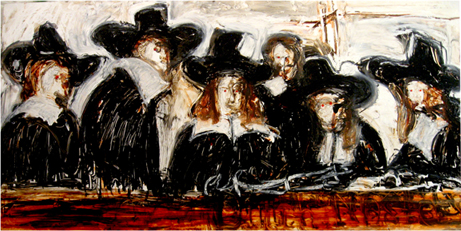Leah Oates: How did you become an artist and did you know early on that you would be in the arts, or did you begin as something else? Where there other artists in your family?
Marcy Brafman: I was always drawing. The first thing I remember doing was drawing. I always thought of myself as an artist even as a very little kid. When I started painting in school I was unsure of myself as everybody else’s work looked so good and polished and mine was such a mess. I liked to draw all the characters first, the narrative and whatnot. Then I remembered I had to fill in the ground and I tried to paint around the detailed story figures. The teacher told my mother that I had a very active imagination.
My father, now deceased, was an artist, a very good one. He gave it up and would never tell us why, and got really angry when my brother and I gave him art supplies as a present one birthday. When he got older and was in ill health he told me that he couldn’t stand the idea of people judging him and his work. I mean, who were they? He hated the idea of my subjecting myself to that scrutiny and the possibility of failure.
He made a living as a Boss Painter, a painting contractor. That man could mix a color like no one else. I learned a lot from him. I still have drawings he made as a teenager. My grandfather was also a house painter.
LO: What are the themes of your work and what inspires you?
MB: I have worked in video and TV and think of myself as a media artist who paints.
My paintings are meditations on Jackson Pollock, the end of nature, comic strips, cartoons, rock n roll, John Singer Sargent, and a long toxic immersion in the living billboard of electronic and digital life. They are mix-mastered with Marshall McLuhan, Velazquez, Karl Marx, Thorsten Veblen, daytime television, and the motion poetry of the great American highway of picture image world. I have an ongoing fascination with character in all its aspects as self-portraiture.
I am super interested in ghosts. Ghost images, ghosting, ghost writing. Vanishing memes, disappearing images, mirrors and doppelgängers, Id and superego. The eternal duality of good and evil, interior and exterior realities.
I’m painting about the Split, the Strike, the Bolt. The verge between sound and picture, time and space, still and motion, light and dark. Being and nothingness, after all – every painter paints himself.
LO: What is your working process? Do you plan things out or play in the studio?
MB: Both.
I do intensive writing, drawing, and picture research online while developing a concept. I also take a lot of pictures. I’m always shooting something glimpsed in the street. Mostly on trucks. I pretty much have a color plan and a compositional strategy. I do an old school “cartoon”- a drawing onto the canvas to start.
Once I get into the work though, the paint takes over. David Gibson called it, “the specific gravity of the paint.” The blueprint of the bollix. We are always surprised by the outcome.
LO: Each artist is so different in how they approach their work. How do you approach the creation of your work?
MB: I consider myself a serious person and a serious artist. But not self-serious, I hope. I feel compelled to make the work I do, like there is a specific number and task list and I have this responsibility within a finite time span to meet the image load.
To me, the painting I admire from the past tells me something about the time it was made in. It reaches out across time to speak to us.
I once saw a Titian where the hand of the Deity reached out to me. I realized that Titian had painted his own hand and he was reaching out over 400 years to me – as if he was present in the room. That is the power of true art.
LO: Why do you think art is important for the world and why is it important for you as an individual artist?
MB: Art is very important because it allows the random to exist. To blossom or fester as you will. It asks people to think about their condition. Good art does that. It makes you think about what is around you. Art is the willing partner of a free society. When people don’t think they are easily led by powers that are not always in their interest. It asks you to take notice about what is true. The nature of things.
It is important to leave a record of the time we lived in.
LO: What advice would you give other artists who are emerging?
Just to keep working. Once you are out of school there are no assignments, no expectations. Just keep working. Or not. Nobody cares until they do. It is up to you to see if your practice is one you need, or the world needs.
LO: Please talk about upcoming bodies of work, shows, etc. that you have coming up.
MB: I am working on a series called “The Ghost Paintings.” So far I have completed “Schizophonia” “TROLL gone Ghost” “Crazy Ghost Fish” and “Dutchmasters (Ghosts of Dutch Repainting.)”I am completing a diptych on small painted panels called “Commedia/Tragedia” and “Maltese Cross on Fire.” Also a series of drawings in color about the nature of alphabets. Just completed “the name of the snow leopard.” A series of drawings of frames from antique black and white television shows. Entitled the “History of Television” series.
I am participating in Lucky Draw 2013 at the Sculpture Center. Summer 2013 I will be installing a piece for Vellum Projects as part of their Sound and Art Purple Satellite Project.
























